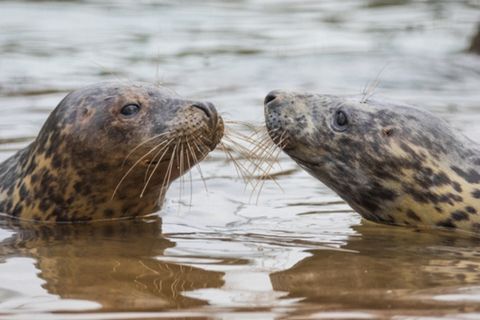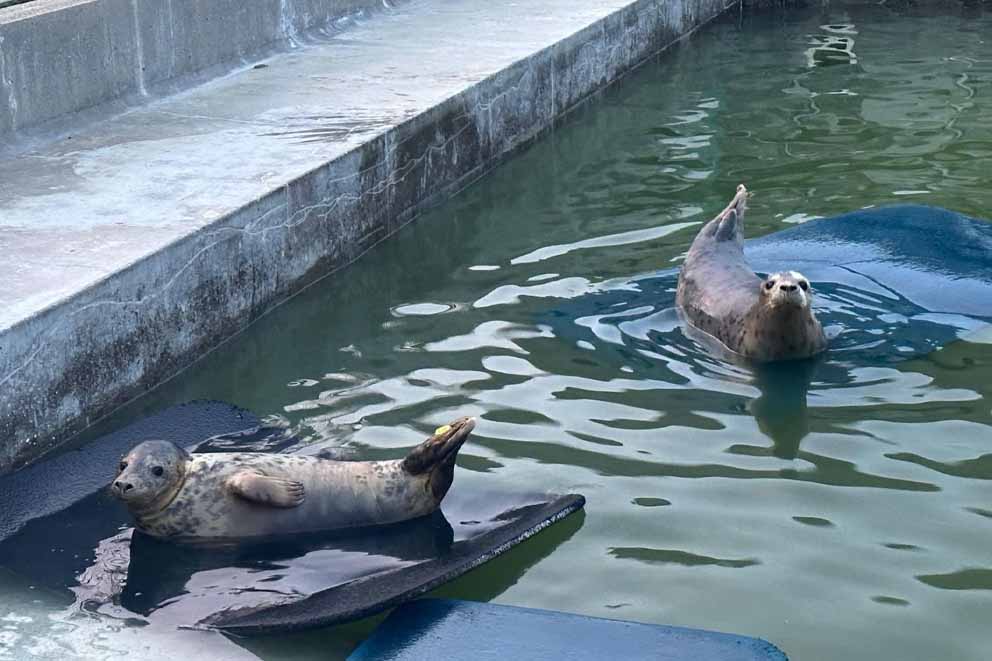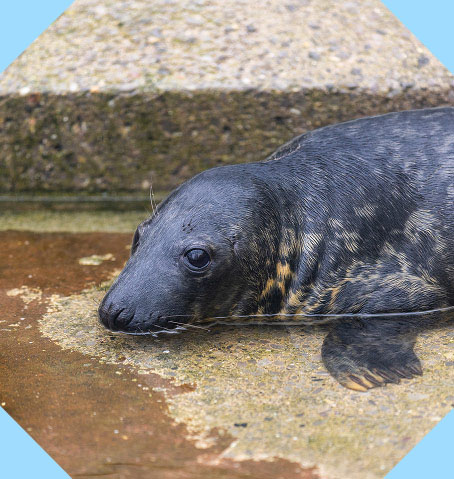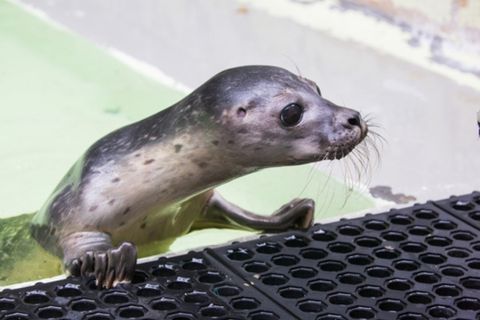Seals are sentient, sociable creatures and experience a range of emotions...
Jump to:
How to identify common vs grey seals
The two types of UK seals – grey seals and common seals – can be found around the coasts of England, Wales, Scotland and Northern Ireland, balancing the ecosystem and recycling nutrients.
You might see grey seals around our northern, eastern and western coastlines, and Wales. Whereas common seals are common to Scotland, as well as our eastern and southwest coast, with one of the largest colonies found in The Wash, Cornwall. They pop up in Northern Ireland, too!
From a distance, both species look similar, but up close you’ll notice a few differences. Here’s how you can tell them apart.
Grey seals
Wide-eyed and whiskered, you can spot grey seals by their:
- Larger body (bigger than common seals!)
- Longer head (longer than common seals!)
- Sloping nose
- Mostly grey colouring, darker on their backs, paler on their bellies, with dark blotches and spots
- Grouping on land: they lie closer together than common seals
Interestingly, grey seals aren’t grey from birth – pups are born fluffy and white! And with around 162,000 grey seals in the UK (compared to approximately 42,900 common seals), the chances are you might spot them somewhere along the coasts, grouped together on land with their body curved, and their head and tail in the air (called a 'banana' pose).

Common seals
Common seals, also known as harbour seals, can be identified by their:
- Smaller body (smaller than grey seals!)
- Shorter head (shorter than grey seals!)
- Concave forehead (it dips a little in the middle)
- V-shaped nostril
- Uniform grey, blonde or black colouring with dark spots
- Grouping on land: they lie further apart than grey seals
Despite their names, common seals are actually less common than grey seals. You might find them nestled by the shore doing their best banana pose, too. Common seals can swim almost immediately after birth.

100km
THE DISTANCE SEALS CAN COVER IN A DAY, AT A TOP SPEED OF 25KM P/H
6 - 10cm
OF THICK BLUBBER (FAT) COVERS A SEAL'S BODY
3m & 300kg
IS THE LENGTH AND WEIGHT BULL SEALS (MALES) CAN GROW
Seal behaviour
Seals, like humans, are intelligent, curious and playful animals that exhibit many different behaviours – these help us understand their natural routines, and the way they communicate with each other.
Seal diet
Seals spend two-thirds of their life at sea, hunting and feeding. They dive for food – sand eels and cod are their favourite – and can stay underwater for 10 minutes or more! However, seals can’t actually breathe underwater – they’re mammals, like us. Instead, their heart rate slows down so they don’t need to breathe as often.
The emotional lives of seals
Seals are sentient creatures and experience a range of rich emotions. They’re also sociable beings, with hundreds and sometimes thousands of seals gathering on rocks or quiet beaches in herds or ‘colonies’. They live in these large groups for safety and survival, particularly during pupping or mating season.
Seals can become stressed when a person or dog gets too close, which can disrupt their digestion and sleep.
test your knowledge
test your knowledge
It's true! From playful curiosity to trembling fear – seals are just like us.
Seal body language
Seal body language can be very expressive.
When they’re sleeping, or not staring in your direction, they’re probably happy. If they look alert, head raised and are repeatedly looking at you, it probably means you’re standing a little too close.
If you see a seal slapping itself, this is a display of strength, communicated to nearby threats via soundwaves.
Seals are also known for making a banana shape with their bodies as they curl up on land, keeping their head and flippers warm by lifting them off the ground.
The seals in our care have unique personalities – like people! Their playful, inquisitive nature helps them learn as they hunt, which is essential as their mums leave them at a young age.
When do seals breed?
Grey seals have their pups at different times of year depending on where they are and they won't head into the water until they are around two to three weeks old.
- 1 Seal mating: Seals gather in the autumn and winter to mate and give birth.
- 2 Seal pregnancy: A seal mum, known as a cow, will be pregnant for around nine to 11 months.
- 3 Seal birth: Common seals give birth to their pups in June and July, and their pups will go into the water soon after they’re born.
Did you know? Seals give birth to only one pup, with hundreds of seals in the colony giving birth at the same time. Yet, somehow, the mum can always spot her pup amongst the crowd, ready to feed them up for three to four weeks, until they triple in weight.

How the RSPCA helps seals
We have four wildlife centres across Sussex, Somerset, Cheshire and Norfolk, each equipped to treat and rehabilitate seals before releasing them back into the wild. Our East Winch Wildlife Centre in Norfolk is the largest of our centres, able to care for 60 to 70 seals at a time – it’s one of the only facilities in England and Wales able to treat adult seals.
We also work closely with other agencies to ensure beaches, rivers and seas are safe for seals, by organising and participating in regular beach clean-ups.
Our wildlife centres
Our four wildlife centres have taken in more than 1,500 common and grey seals over the last five years (2020 to 2024), with 273 seals brought in in 2024. A typical stay lasts around 90 days.
It’s priceless to see seals refreshed and ready to return to their natural habitats. But rehabilitation is costly. It costs between £10,000 to £15,000 to rehabilitate just one adult seal.
Seal rehabilitation
Our wildlife centres come fully equipped with everything a seal could need: veterinary theatres, isolation areas and pools tailored to each stage of the seal’s progress. Our specialist teams provide:
- Fish: orphaned pups are tube-fed 'fish soup' (adults can eat up to 8kg of fish a day!)
- Salt: for treating wounds
- Medication: pain relief and antibiotics
- Water: for cleaning and filling pools
- Fuel: to transport seals for release
- Equipment: to assess, weigh and track seals
Recovery and rehabilitation can take time – some seals stay with us for months. However, it’s important that the seals don’t get too used to humans, as this can be detrimental to their independence and survival in the wild. So, once they’re ready, we release them back into their natural habitat, healthy and happy to be back on the coast.
Seal release
To make it on their own in the wild, seals must reach a target weight that shows they have sufficient fat reserves, and be fit enough to hunt for food. We then carefully plan their release, considering:
- Time of year
- Time of day
- Tide times
- Weather
- Food supply
- Proximity to people and animals
Monitoring
Using identification tags, we monitor their progress in the wild, ensuring they’re surviving and thriving, which also helps us check that our rehabilitation methods are working.
Our tagged seals have been identified in Belgium, the Netherlands, France, and all around the UK.
Related content
Where can you see seals in the UK?
Seals can be found all around the UK coast, but mostly around the north and east. Common seals are found in Scotland, and our eastern and southeast coast whereas grey seals are found mostly around our northern, eastern and western coastlines.
They’ll come onto shore on quiet beaches and rocky areas to rest, digest their food and give birth to their pups. Although they spend most of their time in the sea, it’s completely normal for them to come on to beaches. If you’re lucky, you might even see them resting in the banana pose!
It’s normal to see seals in rivers or water bodies further inland when they’re looking for food. There’s no need to call us for help unless the seal is sick, injured or is stuck between locks or weirs. Crowds can cause stress, so try to stay away and watch them from a distance.

When do seals breed?
Common seals give birth to their pups in June and July, and their pups will go into the water soon after they’re born.
Grey seals have their pups at different times of year depending on where they are. Grey seals that live in the south-west will start having their pups in September, followed by the populations in Scotland in October and November and finishing with seals on the east coast around December. Grey seal pups have white coats, and they won’t go into the water until they’re two or three weeks old.
Watching seals safely
Wild seals are an amazing sight to see, but it’s really important to leave them alone and not get too close.
Disturbing seals when they’re on beaches can mean they can’t sleep or digest their food properly, or mothers and pups could be separated from each other. It’s also dangerous for people or dogs to get too close to them, as seals have a painful bite.
The best thing to do is to move slowly and quietly, paying attention to any signs up on the beach. Always keep at least 100 metres away - that’s about the same length as a full-sized football pitch. Use binoculars to watch them, and keep dogs on a lead or leave them at home if you can.
If the seals are looking at you, then you’re too close and you’ll need to back away quietly. Find more tips on watching seals from the Seal Alliance.
How to tell if a seal is sick or injured
It’s normal for healthy seals to spend time on beaches, so if you see one on a beach there’s no need to worry unless you see any of these signs too
This isn’t a complete list, so if you’re not sure then contact us for further advice.
- They’re tangled in netting, or there’s something stuck around their necks
- You’ve seen the seal being attacked by a dog
- They’ve got injuries or open wounds
- The seal is thin - if you can see their neck clearly, this usually means they’re underweight
- They’re shivering, and you’ve seen them doing this for more than 15 minutes. They might also shiver if they’re frightened, so make sure you’re not too close
- It’s a seal pup that you’ve been monitoring for 24 hours and the mother hasn’t returned
If you’re worried about a seal, then the best way to help is to watch it from a distance. Never try to approach them, touch them or move them back into the sea as this can be dangerous for the seal and make it harder for the experts to rescue them safely. Watch it for an hour or two - they may wander off. After that time if it’s clear that they need help, contact us on 0300 1234 999.
Because cruelty and neglect calls are our top priority, it might take us longer than we’d like to help this seal. We appreciate your understanding.











